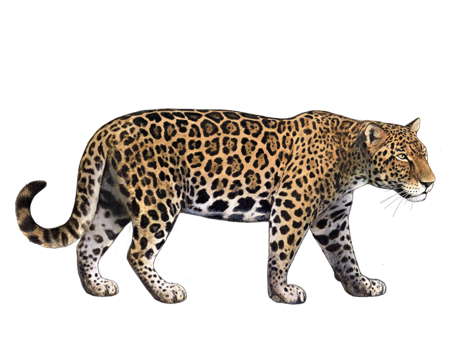
Big Cats
Big Cats are some of the most breathtaking animals on the planet. Though their individual characteristics vary, they share a common ability to captivate humans with their beauty, grace, and mystique.
Interested in discovering if your cat is a Big Cats?
Check out Wisdom Panel's DNA test.
Big Cats Traits
General Appearance
Big Cats vary in size and appearance. Siberian Tigers are the biggest of the group, topping out at 660 pounds. On the other hand, the smallest—Clouded Leopards—can reach 50 pounds.
Coat and Coloring
Big Cats come in various coat colors and patterns. Jaguars, Leopards, and Clouded Leopards all have spotted coats. All three also have ground colors that come in shades of yellow—though the Jaguar also comes in a black variation.
Tigers have tawny or white-colored coats and black vertical stripes. Both male and female lions have tawny-colored coats that provide camouflage. Male lions also have trademark shaggy manes that come in blond, reddish, or black.
Distinctive Physical Traits
Though features vary by species, all Big Cats have muscular bodies, powerful teeth and jaws, and sharp retractable claws.
Big Cats Temperament
Lions are the only Big Cat species that live in groups. Known as prides, these groups include related females, their offspring, and some adult males. The rest of the Big Cats are solitary animals that live and hunt independently (unless it's mating season).
If kept in captivity, Big Cats require large outdoor enclosures where they can roam freely. These spaces should have covers over the top and sides that extend several feet below the surface. In addition to space for physical exercise, Big Cats need plenty of mental stimulation to keep them from getting bored.
It's also important to remember that all Big Cats are predators. Even if they do not act overly aggressive, their sheer size and strength can pose a fatal threat to humans.
Big Cats History
The mysterious origins of Big Cats continue to unfold to this day. Until recently, the oldest Big Cat fossils—dating back 3.8 million years—came from Africa. However, in 2013 researchers discovered a fossil believed to be 5.95 million years old in the Himalayas, suggesting Big Cats actually originated in Asia.
The Big Cat family includes Lions, Tigers, Leopards, Jaguars, and Clouded Leopards. The first four are members of the genus Panthera, whereas the Clouded Leopard is part of the larger subfamily of Pantherinae. Their habitats span regions in Asia, Africa, and North and South America.
Today, Siberian Tigers are the most endangered Big Cat. But all are under threat due to environmental factors, poaching, and human-animal conflict.
Big Cats Care
Nutrition
Like all felines, Big Cats are carnivores, and their diets consist mainly of meat. Depending on their location, they eat everything from antelopes and baby elephants to birds and lizards.
Grooming
Big Cats groom themselves to keep clean and remove their scent—which helps keep potential prey from detecting them.
Health
In captivity, Big Cats need many of the same vaccines as domestic cats to protect them from common feline diseases. However, they require a veterinarian trained and licensed in exotic animal care.
Breed Group
Wild cat
The breeds and populations in this group are, as the name would imply, still considered wild and undomesticated. The Wild Cat Group incorporates the widest range of body sizes and natural habitats of all the breed groups.
Resources
https://www.newscientist.com/article/dn24561-himalayan-fossils-point-to-asian-origin-of-big-cats/
https://matadornetwork.com/read/worlds-7-big-cats-see-wild/
https://bigcatswildcats.com/big-cats/
https://www.thesprucepets.com/big-cats-1236722
https://animals.sandiegozoo.org/animals/clouded-leopard
Reviewed February 23, 2021 by Annette Louviere, DVM


















